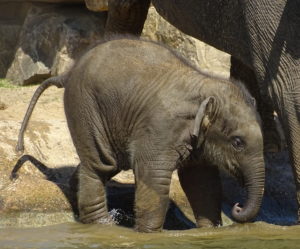
Wildlife conservation is a major focus around the world. With habitat loss and climate change, Asian elephant populations are under severe pressure. Add in an infectious disease that is fatal to the young and you have a recipe for disaster. Even with efforts to breed the endangered Asian elephants in zoos to build the population, elephant endotheliotropic herpesvirus (EEHV) thwarts conservation efforts. EEHV causes hemorrhagic disease in Asian elephants younger than 10 years old, a disease with rapid onset and high mortality. In fact, some numbers indicate EEHV is the cause of death for at least 25% of Asian elephants born in zoos and the wild globally.
What about antiviral drugs? Some of the Asian elephant calves that have been diagnosed were treated with antivirals, but the results were mixed. While a few elephants have recovered when treated; most do not. Finding an effective antiviral starts with research using cultured cells, but methods for culturing other viruses have not worked with EEHV. The inability to study the virus in a laboratory to understand how EEHV interacts with its host hampers the efforts to pursue possible vaccine strategies or screen for effective antiviral compounds.
Traditional conservation efforts (e.g., captive breeding) cannot succeed with EEHV killing 25% of the Asian elephant calves born in captivity. The organization Revive & Restore supports efforts to use genetic tools to rescue endangered species by funding research through their Catalyst Science Fund which Promega has supported. This innovative fund from Revive & Restore awards grants to labs that are exploring the use of biotechnology to solve conservation challenges.
The lab of Dr. George Church, Harvard University, was awarded one of the first grants to synthesize a strand of DNA with the same sequence as the EEHV1A genome, the strain most commonly found in Asian elephant fatalities. The synthesized DNA will then be transfected into cultured elephant cells, which will hopefully produce EEHV viral particles from the synthetic viral genome. If this strategy is successful, the Church Lab will have developed a cell culture platform for propagating EEHV, bringing researchers closer to finding more effective methods to treat and prevent EEHV infection in Asian elephants. This new virus culture method offers the promise of reducing at least one of the conservation challenges facing the endangered Asian elephants and addresses the goals of the Revive & Restore Catalyst Science Fund.
Related Posts
Sara Klink
Latest posts by Sara Klink (see all)
- A One-Two Punch to Knock Out HIV - September 28, 2021
- Toxicity Studies in Organoid Models: Developing an Alternative to Animal Testing - June 10, 2021
- Herd Immunity: What the Flock Are You Talking About? - May 10, 2021
